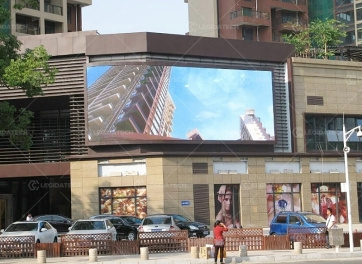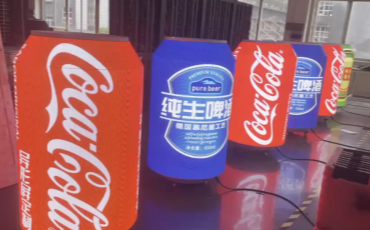Outdoor LED Display Price Range
The price of an outdoor LED screen usually falls between USD 380 and 950 per square meter. The cost goes up as the pixel pitch gets smaller, from P10 → P8 → P6 → P5 → P4.
P10 is the basic choice for outdoor ads and is more affordable. P5 and P4 offer higher clarity and are used on shopping mall facades or city squares, so their price is much higher.
Several clear factors drive the price:
-
Smaller pixel pitch costs more. With a smaller pitch, the screen needs more LEDs and more driver ICs in the same area.
-
Brightness, waterproof rating, and control system also change the cost, because they decide the overall performance of the screen.
-
Bigger projects get a steadier price. When the screen size is large, production and shipping become more efficient, which keeps the unit price more stable.
Common Outdoor LED Screen Types & Reference Prices
| Pixel Pitch | Price Range (USD/㎡) | Recommended Viewing Distance | Typical Applications | Key Features & Notes |
|---|---|---|---|---|
| P10 Outdoor | $280 – $420 /㎡ | 20–30 m | Highway billboards, large advertising boards, long-distance viewing | Cost-effective option; high brightness; stable for big outdoor installations |
| P8 Outdoor | $350 – $520 /㎡ | 15–25 m | City advertising screens, building façades, commercial street displays | Sharper than P10; suitable for medium-range outdoor visuals |
| P6 Outdoor | $420 – $680 /㎡ | 10–18 m | Scenic spots, public squares, government projects | Higher resolution; better detail performance; common for city-level displays |
| P5 Outdoor | $550 – $850 /㎡ | 8–12 m | Shopping mall exterior walls, premium outdoor ads, hotel façades | High-resolution outdoor option; clearer visuals at closer distances |
| P4 Outdoor | $750 – $950 /㎡ | 6–10 m | Landmark media façades, luxury retail, high-end outdoor LED walls | Fine pixel pitch + high brightness; premium choice for detailed outdoor content |
| High-Brightness Outdoor (7000–10000 nits) | Customized pricing | Depends on application | Areas with strong sunlight, airports, transport hubs | Ultra-bright version; upgraded LEDs and ICs; higher power & heat management requirements |
| Energy-Saving Outdoor Series | 10–20% lower power consumption | Same as corresponding pitch | Ads requiring 24/7 operation | Lower electricity cost; optimized driver IC and power supply |
| Front-Service Outdoor LED | Customized pricing | Depends on pitch | Wall-mounted screens, limited maintenance space | Front-service modules; easier maintenance; cabinet cost slightly higher |
| Curved/Custom-Shape Outdoor LED | Project-based pricing | Depends on design | Architectural façades, creative outdoor media | Custom cabinet; flexible design; higher structural and installation cost |
Key Factors That Change the Price
Pixel Pitch
Pixel pitch sets the base cost.
Small pitch means more LEDs. More LEDs mean a higher price.
Viewing distance is simple: P10 for 20 m or more, P5 for 8 m.
Brightness (nits)
Most outdoor screens use 5000–6000 nits.
Places with strong sunlight need 7000–10000 nits.
Higher brightness costs more because the LEDs and driver chips must be stronger.
Waterproof Rating (IP65 / IP66)
Outdoor screens need IP65 or better.
A stronger cabinet, tight seals, and waterproof glue add cost.
But they keep the screen safe in rain and dust.
Cabinet Material
Irons are cheap but heavy.
Aluminum is light and cools better, but it costs more.
LED cabinet material changes the price and affects how easy the screen is to install.

Control System and Refresh Rate
Brands like NovaStar and Colorlight offer different levels of performance.
Higher refresh rates—1920 Hz, 3840 Hz, and 7680 Hz—make the image smoother.
Better driver ICs mean a higher price.
Size and Custom Work
Big projects get a more stable price per square meter.
Custom shapes—curved, corner, and special designs—push the price up because the structure is harder to build.
Price Examples for Different Outdoor Uses
Large Outdoor Billboards
-
Common Specs: P8 or P10
-
Why: These pitches give enough clarity for long-distance viewing.
-
Typical Setup: High brightness (6,000–7,500 nits), basic waterproof cabinet.
-
Price Range: USD 280–480/m²
Shopping Mall Facades
-
Common Specs: Around P6
-
Why: People stand closer, so the screen needs finer detail.
-
Typical Setup: Higher contrast, stable power supply, 24/7 operation.
-
Price Range: USD 450–650/m²
Building Facade Media Walls
-
Common Specs: High-brightness P4–P6
-
Why: Used as a visual landmark; needs clear images in sunlight.
-
Typical Setup: 7,500–10,000 nits, strong waterproof rating, aluminum cabinet.
-
Price Range: USD 550–900/m²
Convention Centers / Cultural Squares
-
Common Specs: P5–P6
-
Why: Events need smooth video, so the refresh rate must be high.
-
Typical Setup: 3,840 Hz refresh rate, stable control system, balanced brightness.
-
Price Range: USD 500–750/m²
What Makes Up the Real Project Cost
The screen price is only one part of your budget. A full outdoor LED project includes several items.
LED Screen Panels
The main cost. Price depends on pixel pitch, brightness, and configuration.
Power Supplies and Cables
Stable power is key for outdoor work. Good brands last longer and reduce failures.
Control Cards and Video Processor
They handle signal input and keep images smooth. Larger screens often need a processor.
Steel Structure and Installation
This part changes a lot. A simple wall mount is cheap. A tall outdoor frame costs more.
Packaging and Shipping
Export projects need wooden cases. Air or sea freight also affects the final cost.
Maintenance and Spare Parts
Extra modules, power supplies, and receiving cards help keep the screen running for years.
Why Outdoor LED Screens Cost More Than Indoor Screens
Outdoor LED screens cost more than indoor ones. The main reason is the environment.
Higher brightness. Sunlight is strong. Outdoor screens need bright LEDs to be visible during the day. The brighter the LEDs, the higher the cost.
Weatherproof design. Outdoor screens face rain, sun, wind, and dust. Cabinets must be sealed. Waterproof glue and gaskets keep water out. Strong cabinets prevent damage in storms.
Cooling system. Outdoor LEDs produce more heat under sunlight. Fans, vents, and better heat dissipation are needed. Good cooling keeps the screen working longer.
Thicker cabinet structure. Outdoor cabinets are thicker and stronger. They protect the screen from wind and accidental impact. Metal or aluminum frames cost more but last longer.
These factors together make outdoor screens more durable, reliable, and naturally more expensive than indoor screens.
Full-Color vs Single-Color/Dual-Color Outdoor LED Screens
Outdoor LED screens come in different color types. The type changes the price.
Single-color screens are the cheapest. They show simple signs and messages.

Dual-color screens cost a bit more. They can display more details and simple graphics.
Full-color screens are the most common. They show videos, ads, and complex visuals. Full-color screens cost the most because they need more LEDs, better control systems, and higher brightness.
Choosing the right color type depends on your content, distance, and budget.
Frequently Asked Questions (FAQ)
Q1: Why is there such a big price difference between P10 and P5?
P5 has smaller pixels. That means more LEDs per square meter. More LEDs need more driver ICs and a stronger control system. That drives the price up. P10 is simpler and cheaper.
Q2: Do outdoor screens always need 7000 nits?
Not always. 7000–10000 nits is for strong sunlight areas. For shaded or medium-light locations, 5000–6000 nits is enough.
Q3: Is P8 the most common choice for outdoor ads?
Yes. P8 balances clarity and cost. It works for most billboards, building façades, and city ads.
Q4: Can I install an outdoor LED screen myself?
It depends on size. Small screens can be DIY, but large panels need a steel structure and professional installers for safety.
Q5: How long does an outdoor LED screen last?
A quality screen lasts 5–8 years. Life depends on brightness, usage, and weather exposure.
Q6: Is maintenance expensive?
Routine maintenance is affordable. Replacing modules, power supplies, or control cards costs extra, but good planning keeps expenses reasonable.
Recommended Reading
Sibling Pages
In-Depth Content
Conclusion
Outdoor LED screens cost more than indoor screens. The price depends on pixel pitch, brightness, waterproof rating, cabinet material, and size.
Smaller pitch and higher brightness increase the cost. Custom shapes or high refresh rates add more. Large projects get a more stable unit price.
Choosing the right screen depends on your content, viewing distance, and budget.
Contact us, a trusted supplier, to get a custom quote (LEGIDATECH). We can help pick the best pitch, brightness, and cabinet for your project.





